
Howell Trevor Pugh, known as H. T. Pugh, was a stonemason who was trained in Wales and worked primarily in Jerome, Idaho. His high quality work popularized the use of lava rock in the Jerome area, eventually including for fine residences in town. More than 20 of his works are preserved and are listed on the National Register of Historic Places.
The Charles Bower House is a historic house located north of Jerome, Idaho, United States. The lava rock house was built by mason H.T. Pugh in 1917. The listing includes a 2.5-acre (1.0 ha) area. In addition to its rock walls, the home features a gable roof with exposed rafters and wide eaves. The original roof was replaced after a 1921 storm. The house was the home of Charles Bower and his family from 1917 until 1922.

The Frank J. Brick House is a house located at 300 N. Fillmore St. in Jerome, Idaho. It was built by stonemason H.T. Pugh in 1917. The lava rock house is topped by a gable roof with four purlins and a dormer on the south side. The house was one of the first lava rock residences constructed in Jerome.

The Jerome First Baptist Church is a church located near Jerome, Idaho that was listed on the National Register of Historic Places in 1983. It was built in 1931 by master stonemason H.T. Pugh and others.

The Jerome City Pump House is a water works building located near Jerome, Idaho that was built in 1922 by stonemason H.T. Pugh. It was listed on the National Register of Historic Places in 1983.

The Clarence Keating House is a house located near Jerome, Idaho, in the United States, that was listed on the National Register of Historic Places in 1983.
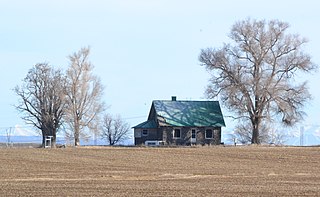
The Thomas J. Kehrer House is a house located near Jerome, Idaho that was listed on the National Register of Historic Places in 1983. It was built in 1917 by master stonemason H.T. Pugh.

The Joseph Mandl House is a house located at 800 N. Fillmore St. in Jerome, Idaho. It was listed on the National Register of Historic Places on September 8, 1983. It was built in 1918 by master stonemason H.T. Pugh.

The Falls City School House is a historic schoolhouse located 3 miles (4.8 km) south and 5 miles (8.0 km) east of Jerome, Idaho. The schoolhouse was built by stonemason H.T. Pugh in 1919; it is one of four schoolhouses built by Pugh. The one-story building has a hipped roof with overhanging eaves. A stone false front over the entrance has a segmental arch and a concrete panel with the school's name. Pugh used concrete blocks, which he made on site, to accent the entrance and the corners of the building. The schoolhouse served Falls City School District 36 until it closed in the 1960s.
The Lulu Graves Farm is a farm located in Jerome, Idaho, United States, listed on the National Register of Historic Places. The 5-acre (2.0 ha) farm includes a house, poultry house, and cattle loafing shed, all of which were built with local lava rock. Lava rock was a popular building material in south central Idaho in the late nineteenth and early twentieth centuries, and many lava rock buildings still survive in the area. The bungalow-style farmhouse was built in 1929 or 1930 by local stonemason H.T. Pugh.
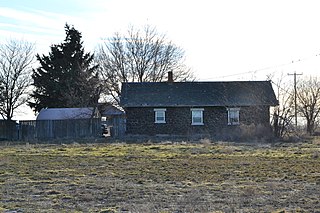
The Merritt Fry Farm is a historic farm located west of Jerome, Idaho, United States. The farm includes three stone buildings: a house, a bunkhouse, and a barn. The house and bunkhouse were built by prominent Jerome stone mason H. T. Pugh and illustrate his ability to match stones, join them with mortar, and use concrete for decoration. Farmer Merritt Fry had the bunkhouse built in 1916; it served as his temporary home until he could build a more permanent house. While farmers frequently built temporary farmhouses, Fry's is unusual in that it uses stone rather than a less sturdy material. The barn followed the bunkhouse in 1926, and Fry's permanent farmhouse was completed in 1930.
The Edward M. Gregg Farm is a historic farm located near Jerome, Idaho. The property includes a farmhouse, bunk house, well house, barn, and chicken house. The buildings were built with lava rock, a popular building material in south central Idaho in the late nineteenth and early twentieth centuries. The one-story house was built in 1914 for Edward M. Gregg, and the remaining buildings were added over the next two decades. The early 1930s well house was designed by local stonemason H.T. Pugh.
The Jessie Osborne House is a house near Jerome, Idaho that was listed on the National Register of Historic Places in 1983. It is an example of the simple rectangular gable-roofed houses built on farms in this area of Idaho. It is unique in that it has not been changed, added on to or enlarged. It was built by master stonemason H.T. Pugh and by Paul Kartsky.

The John F. Schmerschall House is a house located in Jerome, Idaho that was listed on the National Register of Historic Places in 1983. It was built in 1917 by master stonemason H.T. Pugh.
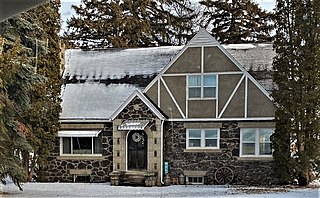
The Julian T. Ricketts House is a historic house built with lava rock in Jerome, Idaho.
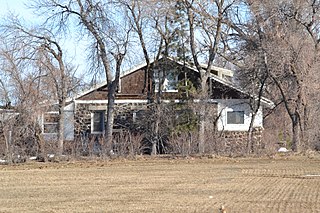
The Don Tooley House is a house located in Jerome, Idaho that was listed on the National Register of Historic Places in 1983. It is a work of master stonemason H.T. Pugh and of John Hadam.

The Sugarloaf School is a school located east of Jerome, Idaho that was listed on the National Register of Historic Places in 1983. It was built in 1924 by master stonemason H.T. Pugh who popularized the use of lava rock in the Jerome area.

The George V. Doughty House and Garage are a historic house and garage located northeast of Jerome, Idaho, United States. The lava rock buildings were constructed in 1914 by stonemason H. T. Pugh for farmer George V. Doughty. The house's design includes a Colonial Revival style hipped roof and a bungalow style front porch.
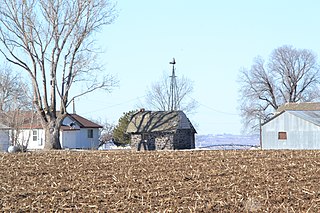
The William H. Cook Water Tank House is a water tank house located southeast of Jerome, Idaho, United States. The building was constructed circa 1915 and was used to store water for William H. Cook's farm. The rectangular building was constructed with lava rock and contains a metal tank. Although the stone craftsmanship in the building is similar to the work of local stonemason H. T. Pugh, the builder of the house has not been determined.
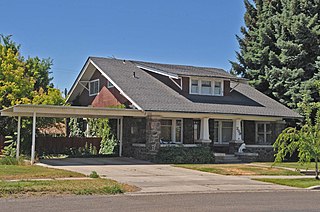
The E. C. Gleason House is a historic house located at 209 East Avenue A in Jerome, Idaho. The house was built in 1918 for farmer E. C. Gleason. Prominent Jerome stone mason H. T. Pugh built the house out of lava rock in the bungalow style. The house was both Pugh's first work within the city of Jerome and his first bungalow; the quality of his work popularized both bungalows and lava rock as a building material in Jerome. The exterior of the house is formed by randomly yet carefully arranged stones joined by dark mortar; its design includes a full porch, wide eaves with diagonal brackets, and dormers with shed roofs on the front and back.
















